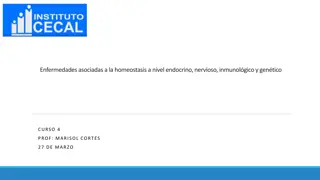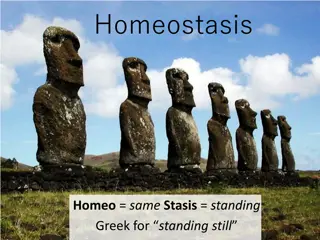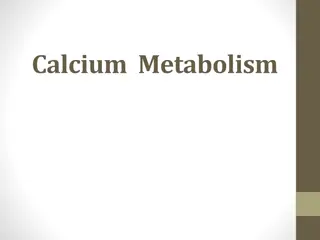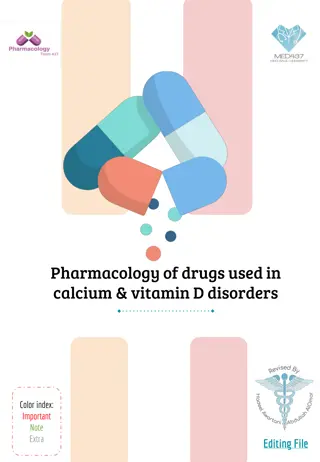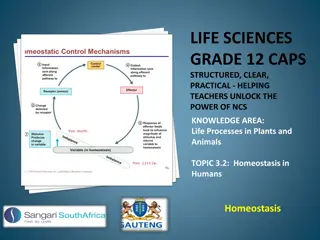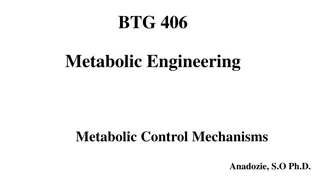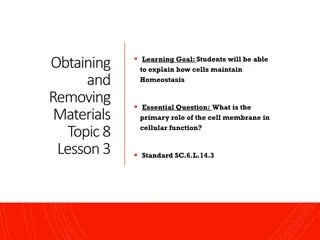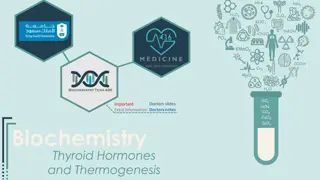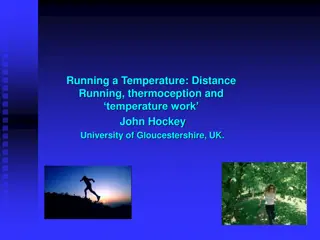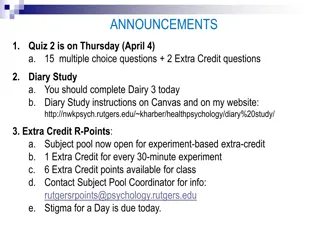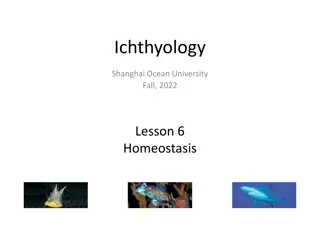Homeostasis
Homeostasis is the body's ability to maintain a constant internal environment, crucial for optimal cell functioning. Explore how mechanisms such as controlling body temperature and volume:surface area ratio contribute to this balance. Discover cooling mechanisms like sweating and the role they play in regulating body heat.
Download Presentation

Please find below an Image/Link to download the presentation.
The content on the website is provided AS IS for your information and personal use only. It may not be sold, licensed, or shared on other websites without obtaining consent from the author.If you encounter any issues during the download, it is possible that the publisher has removed the file from their server.
You are allowed to download the files provided on this website for personal or commercial use, subject to the condition that they are used lawfully. All files are the property of their respective owners.
The content on the website is provided AS IS for your information and personal use only. It may not be sold, licensed, or shared on other websites without obtaining consent from the author.
E N D
Presentation Transcript
Glossary Maintain keep up. Constant the same. Internal inside the body. Environment surroundings of the body.
What is Homeostasis? Body cells work best if they have the correct Temperature Water levels Glucose concentration Your body has mechanisms to keep the cells in a constant environment.
What is Homeostasis? The maintenance of a constant environment in the body is called Homeostasis
Controlling body temperature All mammals maintain a constant body temperature. Human beings have a body temperature of about 37 C. E.g. If your body is in a hot environment your body temperature is 37 C If your body is in a cold environment your body temperature is still 37 C
Controlling body temperature Animals with a large surface area compared to their volume will lose heat faster than animals with a small surface area. Volume = _______ Volume = _______ Surface area = ______ Surface area = ______ Volume : Surface area ratio = ___________ Volume : Surface area ratio = ___________
Controlling body temperature Volume : Surface area ratio = 1:6 Volume : Surface area ratio = 1:5 For every 1 unit of heat made, heat is lost out of 6 sides For every 1 unit of heat made, heat is lost out of 5 sides
Controlling body temperature Volume : Surface area ratio = 1:6 Volume : Surface area ratio = 1:5 The bigger the Volume : Surface Area ratio is, the faster heat will be lost.
What mechanisms are there to cool the body down? 1. Sweating When your body is hot, sweat glands are stimulated to release sweat. The liquid sweat turns into a gas (it evaporates) To do this, it needs heat. It gets that heat from your skin. As your skin loses heat, it cools down.
Sweating The skin
What mechanisms are there to cool the body down? 2. Vasodilation Your blood carries most of the heat energy around your body. There are capillaries underneath your skin that can be filled with blood if you get too hot. This brings the blood closer to the surface of the skin so more heat can be lost. This is why you look red when you are hot!
This means more heat is lost from the surface of the skin If the temperature rises, the blood vessel dilates (gets bigger).
What mechanisms are there to warm the body up? 1. Vasoconstriction This is the opposite of vasodilation The capillaries underneath your skin get constricted (shut off). This takes the blood away from the surface of the skin so less heat can be lost.
This means less heat is lost from the surface of the skin If the temperature falls, the blood vessel constricts (gets shut off).
What mechanisms are there to warm the body up? 2. Piloerection This is when the hairs on your skin stand up . It is sometimes called goose bumps or chicken skin ! The hairs trap a layer of air next to the skin which is then warmed by the body heat The air becomes an insulating layer.
Controlling Glucose levels Your cells also need an exact level of glucose in the blood. Excess glucose gets turned into glycogen in the liver This is regulated by 2 hormones (chemicals) from the pancreas called: Insulin Glucagon
Glycogen If there is too much glucose in the blood, Insulin converts some of it to glycogen Glucose in the blood
Glycogen If there is not enough glucose in the blood, Glucagon converts some glycogen into glucose. Glucose in the blood
Diabetes Some people do not produce enough insulin. When they eat food, the glucose levels in their blood cannot be reduced. This condition is known as DIABETES. Diabetics sometimes have to inject insulin into their blood. They have to be careful of their diet.
Glucose levels rise after a meal. Insulin is produced and glucose levels fall to normal again. Glucose Concentration Normal Time Meal eaten
Glucose levels rise after a meal. Glucose Concentration Diabetic Insulin is not produced so glucose levels stay high Time Meal eaten
Glycogen The glucose in the blood increases. insulin to convert it into glycogen. to dangerous levels. But there is no Glucose concentration rises Glucose in the blood
Controlling water levels The control of water levels is carried out by the KIDNEYS. It is closely linked to the excretion of urea. Urea is a waste product that is made when the LIVER breaks down proteins that are not needed by the body. Urea contains the element Nitrogen.
The kidneys The kidneys clean the blood of waste products and control how much water is kept in the body. The waste products and water make up urine which is excreted via the ureter. Dirty blood enters the kidney through the renal artery. Then, several things happen to clean the blood...
1. Filtration Blood enters the tubule area in a capillary. The capillary forms a small knot near the kidney tubule. The blood is filtered so all the small particles go into the tubule. The capillary then carries on to run next to the tubule.
The kidney tubule now contains lots of blood components including: Glucose: Ions: Water: Urea:
2. Reabsorb sugar The body needs to have sugar in the blood for cells to use in respiration. So all the sugar is reabsorbed back into the capillary.
2. Reabsorb sugar The body needs to have sugar in the blood for cells to use in respiration. So all the sugar is reabsorbed back into the capillary.
3. Reabsorb water Water and ions are the next to be absorbed. It depends on how much is needed by the body.
3. Reabsorb water Water and ions are the next to be absorbed. It depends on how much is needed by the body.
Reabsorbing water If you have too little water in your blood, you will produce very concentrated urine. If you have too much water in your blood, you will produce very dilute urine. (very little water in it) (lots of water in it)
5. Excrete the waste Everything that is left in the kidney tubule is waste: All the urea Excess water This waste is called urine. It is excreted via the ureter and is stored in the bladder. Renal vein The clean blood leaves the kidney in the renal vein. Ureter
Summary of urine production Urea is a waste product made in the LIVER Water content of the body is controlled in the KIDNEYS Urea, water and other waste makes up URINE. Urine travels down the URETER and is stored in the BLADDER Urine is excreted through the URETHRA.
This powerpoint was kindly donated to www.worldofteaching.com http://www.worldofteaching.com is home to over a thousand powerpoints submitted by teachers. This is a completely free site and requires no registration. Please visit and I hope it will help in your teaching.


